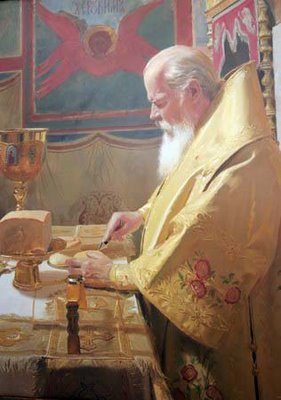 His Holiness was not a Russian, but an Estonian. He was born Alexis Michaelovitch Ridiger, on 23 February 1929 (Old Style), the son of a priest of the Estonian Orthodox Church, and a member of the nobility of the Baltic States, who were of German origin in the Russian Empire. He grew up when the Nazis occupied Estonia and he helped his father in his ministry to those who had been interned in concentration camps.
His Holiness was not a Russian, but an Estonian. He was born Alexis Michaelovitch Ridiger, on 23 February 1929 (Old Style), the son of a priest of the Estonian Orthodox Church, and a member of the nobility of the Baltic States, who were of German origin in the Russian Empire. He grew up when the Nazis occupied Estonia and he helped his father in his ministry to those who had been interned in concentration camps.
He married in 1950 Vera Alekeseeva, but the marriage was short-lived and within the year it was dissolved; and the same year he was ordained a priest. His rise in the hierarchy was swift, and in 1961 he was consecrated bishop for Tallinn, the Estonian capital. It was rumoured that Alexis was a member of the secret service, the K.G.B., on the grounds that he had a code name “Drozdov” (“Blackbird”), but the Soviets tended to give code names to important figures whether they were Soviet agents or not. It has always been strenuously denied that he was an agent of the K.G.B.
In 1986 he became Metropolitan of Novgorod and Leningrad, the next see below that of Moscow itself, and on the death of Patriarch Pimen of Moscow, Alexis was elected to the Patriarchal throne, taking the name Alexis II in honour of Alexis I (Simansky), who had led the Russian Church through the Stalinist period and the notorious siege of Leningrad, when he was Metropolitan of that city in World War II.
Alexis II succeeded to the patriarchate in 1990 at a time of transition for the Russian Church. A year earlier the Berlin Wall had been torn down marking the beginning of the end of Communism in Europe. The government began to relax its grip on the Church and to hand back a multitude of church properties: churches, monasteries and convents in various states of decay and dereliction. Alexis set to work to restore these places and to place monks and nuns in them. The most spectacular restoration or total re-building was the Church of the Saviour in Moscow, which Stalin had razed to the ground to build a swimming pool. The Donskoi and Danilovsy monasteries were restored and re-inhabited, as was the famous convent of the Novodevichy, all of them in Moscow. It was becoming a far cry from the years of Terror when Patriarch Sergius was encamped in a caravan, until he managed to secure the old Imperial German embassy in Chisty Lane, Moscow, as his official residence.
Patriarch Alexis II was a conservative in religion and was not at the forefront of the Ecumenical Movement. He nursed a certain hostility towards Rome, which he thought was encroaching on Orthodox territory, while he seemed to ignore the number of diocese and parishes established by the Orthodox in traditional Catholic countries in Western Europe. His hostility was not confined to the so-called Uniate Churches, but also to the Latins in the former Soviet Union, the descendants of Lithuanians and others of Catholic origin, who had been deported to Siberia by Stalin. No protests at their deportation seem to have been made by the Russian Church at that time. Rome realized that these lost Catholics needed to be looked after spiritually, just as the Russian émigrés in Western Europe needed spiritual sustenance in their own tradition. From time to time Alexis II found himself at odds with the Ecumenical Patriarch of Constantinople, particularly over the question of the autocephaly of the Estonian Orthodox Church, until recently under the Moscow Patriarchate, but latterly taken under the omophorion of the Ecumenical Throne. Estonia particularly rankled with Alexis as an Estonian Orthodox himself.
Alexis’s great achievement was the reconciliation of the Moscow Patriarchate and the Russian Orthodox Church Outside Russia, which, having moved from Constantinople, to Sremsky-Karlovsky in Serbia, then to Munich, finally had its headquarters in New York. In 2007 he and the late Metropolitan Lavrus signed a concordat, which brought the two parts of the Russian Orthodox Church into visible union, although certain parishes and religious houses could not accept the union and the monastery of St. Edward at Brookwood, the Convent of the Annunciation in Willesden, West London, and the Leshna Convent in Normandy, together with certain parishes and individuals allied themselves with the Greek Old Calendarist Church of The Resistance. This was a disappointment to Alexis, but not such a trauma as the loss of so many parishes in the Ukraine, where two Orthodox Patriarchates now existed alongside the Moscow Patriarchate and the Old Believers of the Byelo-Krinitza Concord.
Alexis II came to the patriarchal throne when Russia was in a certain amount of turmoil and when various American-based sects were seizing the opportunity of setting up missions to convert the Orthodox, and when ultra-nationalism was raising its head and the revival of anti-semitism was underway, something which Alexis was quick to condemn.
It is, perhaps, too early to judge his legacy, but his cool guidance of the Russian Church helped it to adjust to the new situation and the collapse of Communism and the return of many to the Church, so that today it is reckoned that two-thirds of the Russian nation regard themselves as “Pravoslavenie”, Orthodox.
May the memory of the Servant of God Alexis be Eternal!
